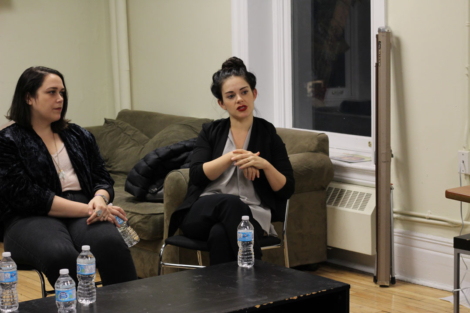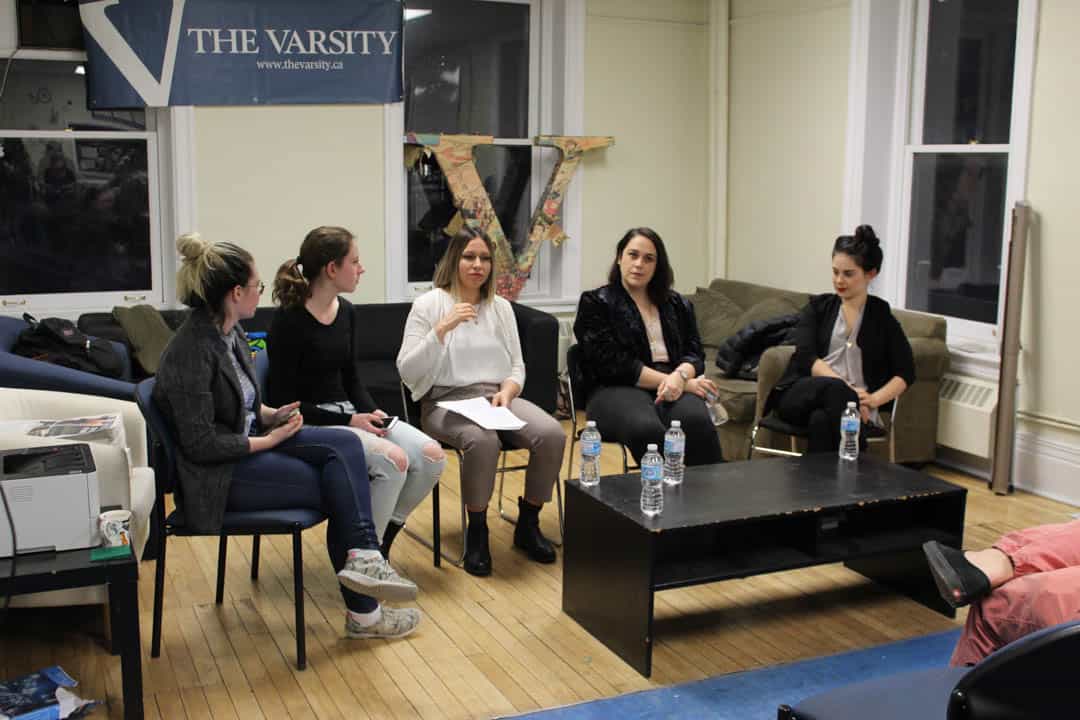[dropcap]A[/dropcap]t the end of the last academic year, my friend Tamsyn Riddle announced she was filing a human rights complaint against U of T and Trinity College for their handling of her sexual violence complaint. Shortly after, I was elected as The Varsity’s Features Editor. Throughout the summer, while working a nine-to-five job, I began preparing potential feature stories for this year. Following the aftermath of ex-CBC radio host Jian Ghomeshi’s sexual assault acquittal, I was adamant that the issue of sexual violence needed to be covered in-depth in my section — I just didn’t know how.
It was sometime during my two-hour commute to work that I came up with the idea for a series on the subject. I wasn’t entirely sure how it would look, but I knew it would be a multifaceted endeavor.
In the middle of the summer I caught up with Riddle in a small Annex diner. I wanted to get her opinion on the potential series. She liked the idea, agreed the issue should be covered, and expressed interest in writing a feature on her experience reporting her assault to the university.
Her article was published on September 25. In the process of editing the story, I had multiple conversations with the Editor-in-Chief and Riddle herself on whether to name faculty and staff members relevant to her story. Because the story was a first-person narrative, it didn’t make sense to reach out to those mentioned for comment. Instead, with Riddle’s permission, we included an editor’s note at the top of the article explaining that “allegations made toward the faculty members and staff members identified in this article are unproven in court;” Riddle could write an open account of her experience, and The Varsity could protect itself legally.
The conversations we had in the newsroom regarding this article were crucial. We all recognized the importance of publishing the story, but the path to doing so was not clear-cut. I wanted Riddle’s story published, but I also wanted to ensure I was being fair to all those involved. Ultimately, the topic of the Responsible Reporting on Sexual Violence panel, hosted at The Varsity on November 15, stemmed from this tension: how should journalists cover stories of sexual violence in a respectful and responsible way?
I had the privilege of hosting this panel discussion and moderating it with Riddle. The Varsity collaborated on the event with a sexual violence activist organization at U of T that Riddle is a member of called Silence is Violence. The panelists came from an array of backgrounds and spoke from varying perspectives. Shannon Giannitsopoulou is the co-founder of femifesto, a feminist organization based in Toronto. She is also a contributing writer for “Use the Right Words: Media Reporting on Sexual Violence in Canada,” a guide for the media when covering issues concerning sexual violence. Her perspective was valuable at the panel because it is not from inside the media itself, but rather from working to educate those who work in the media and how they should cover the subject.
Lauren McKeon, our second panelist, has primarily worked in magazines. She is currently the digital editor at The Walrus and a contributing editor at Toronto Life. McKeon also taught at Humber College and is the author of F-Bomb: Dispatches from the War on Feminism. Her article for Toronto Life, “Fifteen years of silence: I was raped three times in less than 10 years. I knew all of my attackers. This is my story,” was an honest and raw portrayal of the experiences of a sexual violence survivor. I was grateful to have her speak at the event.
Our final panelist, Robyn Doolittle, broke one of the largest stories in recent Canadian history on police treatment of those who formally report their sexual assaults. Her investigation took approximately 20 months, during which she explored instances of police dismissing sexual assault cases as “unfounded” — essentially, when police believed the assault never occurred. Before this “Unfounded,” article, Doolittle wrote for the Toronto Star covering former Toronto Mayor Rob Ford. Given the breadth of her coverage and implications it has had on policy, we were happy to have her attend the panel.
With the unique experiences of these three women, the conversation was extremely insightful. It explored questions that I had as a student journalist who has covered this topic, and it showcased perspectives I hadn’t considered. In this vein, I thought it was fitting to break down the key issues discussed at the event — for the public, for journalists, and for myself.
[pullquote]We need to take this moment now as journalists to look at what stories aren’t being told…what we’re missing, what we’re going to tell, and how we’re going to tell it.[/pullquote]
SEXUAL VIOLENCE REPORTING IN THE MEDIA
Over the last few weeks, the outcry of sexual assault allegations against multiple men in Hollywood has been astonishing. Riddle asked the panelists how these stories and similar ones impacted conversations about sexual violence and its media coverage.
Giannitsopoulou began by mentioning that, when working on femifesto’s guide in 2011, a lot of these large stories were not yet published. She’s pleased that the guide was created before the Ghomeshi case and the Harvey Weinstein scandal because it’s readily available at a time when reporters need it.
Giannitsopoulou also discussed the importance of diversity of stories, paying particular attention to whose stories are told and which stories garner attention and space. She said, “Indigenous women from Saskatchewan that were missing… have 3.5 times less coverage than women in Ontario that were also murdered and missing. And they were less likely to have images of the women.” Giannitsopoulou continued by pointing out that Indigenous women who are shown in newspapers are more likely to be “on the corner of the page and not on the front page.”
McKeon agreed with Giannitsopoulou, saying, “I think we need to take this moment now as journalists to look at what stories aren’t being told… what we’re missing, what we’re going to tell, and how we’re going to tell it.” Given the increasing coverage of this subject, McKeon said that “now’s the time that there is this appetite for [sexual violence coverage] and people are really listening… which is both encouraging and a little depressing.”
Doolittle discussed the impact these stories have had on policy given the increased attention. She specifically spoke about the implications of her Unfounded series: “since Unfounded ran in February… something like half of the police services in this country have reviewed thousands of sexual assault cases, they’re passing policies around having supervisors involved in decisions, they’re doing a training overhaul that takes the neurobiology of trauma into account, the federal government has committed a hundred million dollars to address violence against women.”

MIN HO LEE/THE VARSITY
TERMINOLOGY IN SEXUAL VIOLENCE STORIES
Language was, unsurprisingly, discussed at length. I asked the panelists what process journalists should follow when choosing language and phrasing about sexual violence. The question stemmed from my understanding of sexual violence terminology, specifically the common use of the term ‘survivor’ over ‘victim.’
Acknowledging that wording can be “tricky,” Giannitsopoulou stressed the importance of ensuring the consent of a source when deciding how they will be identified in a story: “I personally prefer the word ‘survivor.’ I think it underlines resilience. But some people don’t like the word ‘survivor’, some people prefer the word ‘victim’ because it speaks to their experience of healing.”
While objectivity is key when reporting, Giannitsopoulou mentioned that all language has connotations and that “no language is neutral.”
Doolittle mentioned that the “Use the Right Words” campaign Giannitsopoulou has worked on in femifesto has taught her a lot as a journalist. “What it’s really taught me is that journalists are very careful about some of the language they use around sexual assault allegations and not careful around allegations for other crimes.”
Instead of removing the term ‘allegedly’ when reporting on sexual violence, Doolittle suggested that news reporters and investigative journalists actively include the term when referring to other types of crime. In doing so, the term ‘allegedly’ is no longer associated with sexual violence but rather all unproven crimes. Additionally, Doolittle doesn’t use the terms ‘survivor’ or ‘victim’ in her reporting unless a court ruling is made — she often uses the term ‘complainant’ instead.
“If I say someone was a victim of sexual assault, I am saying it happened. If I say they were a victim, I am saying it happened. And, it’s not that I don’t believe them… but I do the story a disservice by not being as objective as possible,” said Doolittle.
McKeon spoke on the relationship between language, communication, and trust, saying that once trust is broken between a reporter and their source there’s little way to reclaim it. Because sexual violence survivors already face high rates of skepticism, confidence in a reporter for accurately sharing their stories is imperative, McKeon added.
HOW #METOO AND SOCIAL MEDIA ACTIVISM SHAPES COVERAGE
Given the virality of the #MeToo campaign following Weinstein’s coverage and the popularity of the hashtag #BeenRapedNeverReported a few years earlier, I was interested in what the panelists thought about social media activism, if it has helped progress conversations, and if it has influenced their work.
McKeon said that social media activism encouraged her to come forward with her own story, and that online activism and hashtags have the potential to build a community. However, she said that journalists should use online sexual violence trends as “a launching off point.”
“What we have to do though is find a way to move beyond those hashtags in our reporting, because they don’t tell the whole story,” said McKeon.
Doolittle expressed that the power of #MeToo was in demonstrating both explicit instances of sexual violence and injustices that women face on a daily basis.
Giannitsopoulou discussed the subject of social media activism and the #MeToo campaign as requiring nuance: “I’m glad that people are sharing their stories, but I don’t want survivors to feel like if they’re not feeling safe or if they don’t want to share their stories that their experience as a survivor is not valid.
“I would also not like to put the onus on survivors to have to keep telling our stories when we know one in three women, one in six men have experienced sexual violence in their lifetime, and [for] trans and non-binary folks it’s disproportionately higher than that,” said Giannitsopoulou.
Throughout my process of organizing and moderating this panel, one common theme stood out: consent in reporting. While there are a variety of considerations to take into account when reporting on issues of sexual violence — and I definitely learned a lot — it’s important to remember that, as McKeon stated, “No survivor owes you their story.”
It is crucial for us as journalists to ensure open communication, respect, and to uphold the consent of survivors in each step of the publishing process. This includes consent with terminology, consent to going on record, and consent to sharing their story.
— With files from Priyanka Sharma.

MIN HO LEE/THE VARSITY
Watch the full livestream on the panel on Facebook.


